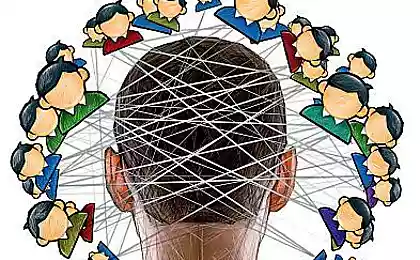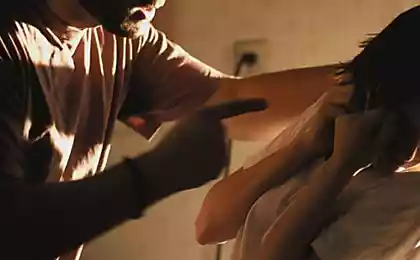1014
Kiberbulling - an innovative way to child abuse
Progress - a versatile piece, which, together with the use and development brings new risks and challenges. That kiberbulling - one example of this problem. This is a fairly new concept in our country, which has come to us from the West, along with chat rooms and social networks.

Kiberbulling - a form of intimidation, harassment, violence and bullying of children and young people with the help of information and communication technologies - ie, mobile phones and the Internet. But it thrives, certainly in the network - there is a springboard for bullying and even crimes is very broad.
The main problem of the virtual space is that communication via the World Wide Web is the lack of direct interpersonal contact, that is, we do not see his counterpart and, accordingly, can not fully be sure of who he really is. Thus, each of us can think of himself totally new "role", the new behavior, a new life. And it is very unlikely that casual acquaintances of the "web" once find out the truth. And in this his "new life" we do not have to answer for his statements, actions and deeds - in the end, we did not do it on my own, so that you can behave as you like. Naturally, this often, sometimes not without pleasure, teenagers are in relation to each other, as well as adults with psychological problems.
Kiberbulling consists of a set of methods for the intimidation and harassment of their "potential victims»:
Anonymous threats - send emails without a signature to e-mail their "potential victims", which spelled out the insults, intimidation, often using profanity.
Harassment - a common long-term delivery of its "potential victim" via mobile phone and e-mail messages, and in the future - blackmailing her by any facts with her own personal life.
Use of personal information - private information about the "potential victim" after hacking her email or a page on the social networks and the use of blackmail or bullying.
Flaming - a short exchange of emotional cues between two people - the aggressor and "potential victim" (sometimes aggressors may be several). The goal of the aggressor - humiliate "victim" and thereby get pleasure from it.
Heppisleping - a video in which the real filmed scenes of violence in society. Most often, these rollers are placed on such resources where they can be viewed by millions of people. Naturally, these videos, in most cases, "poured" into the network without the consent "of potential victims».
Recently, the "hotline" received a call:
Hello! I do not know how to solve a problem that occurred with my child. In my 15-year-old daughter was attacked by three of her classmates. My daughter is dating a guy who she met up with one of her classmates. When the girls found out about it, after school "scored an arrow" my daughter. She came to the appointed place, and the girls immediately attacked her and began to beat him, dragged by the hair, call the last word. One of the company all the time standing on the sidelines and was filming the video. Then this video is uploaded to YouTube and send the link to all friends. These girls, among other things, and even brag to their peers, they "teach a lesson" My girl, they say, "let him know how the guys take away other people's." And I'll never know how I can help my daughter and punish its offenders ».
In this situation, we can say that one thing when classmates simply decided to find out the relationship (through conversation or a fight), and quite another - as of this "dismantling" even know countless friends and strangers, and moreover, there is preserved artifact. This is a much more serious problem in terms of the psychological state and non-pecuniary damage.
Why children do kiberbullingom?
To argue on this subject can be long and not always able to get to the truth of cause and motive of the individual. Some, for example, find it ridiculous and funny way to assert themselves; others - want revenge, "that's that girl who fought off my guy"; and others - want more to make fun of a classmate, who was already a long time ago written off at the rows of losers, that is, to "finish" the weak; fourth - just doing forbidden things, because "we are in fact for it will be nothing -Because no one can prove." But this is only the laws, but their personal and, therefore, a purely individual coming from a unique life experience, maybe even as much as necessary. Also, do not forget about the growing "degree" of cynicism, immorality and cruelty of modern society.
But back yet to the laws, consider the standard structure kiberbullinga the example of the participants and their psychological portraits:
1. The aggressor - an impulsive man who wants to be chief over all and wants to be listened to and all were afraid of; aggressively tuned not only to peers, but also to adults (parents, teachers); is not able to sympathize; physically stronger "potential victims».
2. The potential victim - a man introverted, shy and sensitive, which is easily frightened; unsure of himself, madly in all experiencing, has low self-esteem; depression, often thinking about suicide; He has no close friends; communicate more with adults than with their peers; physically weaker "aggressor».
3. The observer - a person who is very much interested to see the (in some cases, to fix) the process of persecution and humiliation of one person over another.
If the child was the "potential victim" in kiberbullinga, he is very scary to tell an adult about it. This can happen for various reasons: the children may feel that adults will not be able to solve a problem of this kind; children think that adults do not perceive their problem as serious; Children believe that if talk about this problem to some of the adults, they will only get worse - will work as a kind of "a denunciation of the aggressor", which is generally good not wait.
But if you see that your child has changed a lot, if you feel that it is something not so, try to bring it to a frank conversation. Just do not be yelling and morals do not need loud phrases like: "But I was your age ..." and "I told you so!". Your daze and so hard. And you, in the first place, it should be for the other, which the child can really trust.
Figure out what's what, you should identify the people who can be contacted to resolve the situation. If it was in school - should be discussed with teachers, principals, with parents "aggressor", and directly with own "aggressor." Of course to beat and insult the latter is not necessary, but indicate his position and the position of "victim", as well as yours, as a parent of the victim - is a must. Explain that the wrongs done in the virtual Internet space as real as spoken face to face.
If the bullying go all the frames, it is possible to apply and the law enforcement agencies, or to transfer the child to another school.
Kiberbulling dangerous not less than bullying in the conventional sense. And this problem affects not only children and adolescents - those directly involved, but also adults who need support and help to their children in such a situation, as well as prevent them. Many children who are "potential victims" kiberbullinga, unable to withstand such a psychological blow, saying goodbye to life.
To prevent the problem kiberbullinga parents should be from an early age to teach your child to safely use your computer, the Internet and other information and communication technologies and to warn that the problems arising in the virtual space also need to share and to solve them together.

Kiberbulling - a form of intimidation, harassment, violence and bullying of children and young people with the help of information and communication technologies - ie, mobile phones and the Internet. But it thrives, certainly in the network - there is a springboard for bullying and even crimes is very broad.
The main problem of the virtual space is that communication via the World Wide Web is the lack of direct interpersonal contact, that is, we do not see his counterpart and, accordingly, can not fully be sure of who he really is. Thus, each of us can think of himself totally new "role", the new behavior, a new life. And it is very unlikely that casual acquaintances of the "web" once find out the truth. And in this his "new life" we do not have to answer for his statements, actions and deeds - in the end, we did not do it on my own, so that you can behave as you like. Naturally, this often, sometimes not without pleasure, teenagers are in relation to each other, as well as adults with psychological problems.
Kiberbulling consists of a set of methods for the intimidation and harassment of their "potential victims»:
Anonymous threats - send emails without a signature to e-mail their "potential victims", which spelled out the insults, intimidation, often using profanity.
Harassment - a common long-term delivery of its "potential victim" via mobile phone and e-mail messages, and in the future - blackmailing her by any facts with her own personal life.
Use of personal information - private information about the "potential victim" after hacking her email or a page on the social networks and the use of blackmail or bullying.
Flaming - a short exchange of emotional cues between two people - the aggressor and "potential victim" (sometimes aggressors may be several). The goal of the aggressor - humiliate "victim" and thereby get pleasure from it.
Heppisleping - a video in which the real filmed scenes of violence in society. Most often, these rollers are placed on such resources where they can be viewed by millions of people. Naturally, these videos, in most cases, "poured" into the network without the consent "of potential victims».
Recently, the "hotline" received a call:
Hello! I do not know how to solve a problem that occurred with my child. In my 15-year-old daughter was attacked by three of her classmates. My daughter is dating a guy who she met up with one of her classmates. When the girls found out about it, after school "scored an arrow" my daughter. She came to the appointed place, and the girls immediately attacked her and began to beat him, dragged by the hair, call the last word. One of the company all the time standing on the sidelines and was filming the video. Then this video is uploaded to YouTube and send the link to all friends. These girls, among other things, and even brag to their peers, they "teach a lesson" My girl, they say, "let him know how the guys take away other people's." And I'll never know how I can help my daughter and punish its offenders ».
In this situation, we can say that one thing when classmates simply decided to find out the relationship (through conversation or a fight), and quite another - as of this "dismantling" even know countless friends and strangers, and moreover, there is preserved artifact. This is a much more serious problem in terms of the psychological state and non-pecuniary damage.
Why children do kiberbullingom?
To argue on this subject can be long and not always able to get to the truth of cause and motive of the individual. Some, for example, find it ridiculous and funny way to assert themselves; others - want revenge, "that's that girl who fought off my guy"; and others - want more to make fun of a classmate, who was already a long time ago written off at the rows of losers, that is, to "finish" the weak; fourth - just doing forbidden things, because "we are in fact for it will be nothing -Because no one can prove." But this is only the laws, but their personal and, therefore, a purely individual coming from a unique life experience, maybe even as much as necessary. Also, do not forget about the growing "degree" of cynicism, immorality and cruelty of modern society.
But back yet to the laws, consider the standard structure kiberbullinga the example of the participants and their psychological portraits:
1. The aggressor - an impulsive man who wants to be chief over all and wants to be listened to and all were afraid of; aggressively tuned not only to peers, but also to adults (parents, teachers); is not able to sympathize; physically stronger "potential victims».
2. The potential victim - a man introverted, shy and sensitive, which is easily frightened; unsure of himself, madly in all experiencing, has low self-esteem; depression, often thinking about suicide; He has no close friends; communicate more with adults than with their peers; physically weaker "aggressor».
3. The observer - a person who is very much interested to see the (in some cases, to fix) the process of persecution and humiliation of one person over another.
If the child was the "potential victim" in kiberbullinga, he is very scary to tell an adult about it. This can happen for various reasons: the children may feel that adults will not be able to solve a problem of this kind; children think that adults do not perceive their problem as serious; Children believe that if talk about this problem to some of the adults, they will only get worse - will work as a kind of "a denunciation of the aggressor", which is generally good not wait.
But if you see that your child has changed a lot, if you feel that it is something not so, try to bring it to a frank conversation. Just do not be yelling and morals do not need loud phrases like: "But I was your age ..." and "I told you so!". Your daze and so hard. And you, in the first place, it should be for the other, which the child can really trust.
Figure out what's what, you should identify the people who can be contacted to resolve the situation. If it was in school - should be discussed with teachers, principals, with parents "aggressor", and directly with own "aggressor." Of course to beat and insult the latter is not necessary, but indicate his position and the position of "victim", as well as yours, as a parent of the victim - is a must. Explain that the wrongs done in the virtual Internet space as real as spoken face to face.
If the bullying go all the frames, it is possible to apply and the law enforcement agencies, or to transfer the child to another school.
Kiberbulling dangerous not less than bullying in the conventional sense. And this problem affects not only children and adolescents - those directly involved, but also adults who need support and help to their children in such a situation, as well as prevent them. Many children who are "potential victims" kiberbullinga, unable to withstand such a psychological blow, saying goodbye to life.
To prevent the problem kiberbullinga parents should be from an early age to teach your child to safely use your computer, the Internet and other information and communication technologies and to warn that the problems arising in the virtual space also need to share and to solve them together.
New Zealand recognized kiberbulling crime. Say NO to social networks.
MOTHER MOTHER'S TREATS WORDS OR CONSPIRACY TO HAPPINESS























